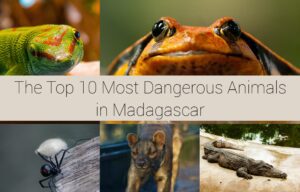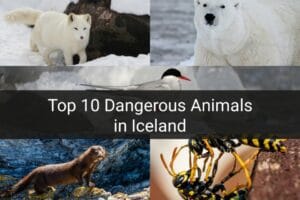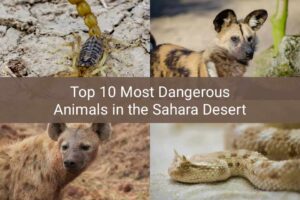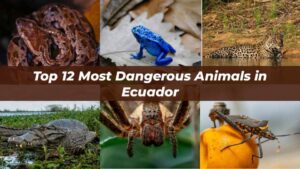Indonesia is one of the most popular countries in Southeast Asia, and wildlife travellers flock here yearly due to the abundance of animals like rhinos, tigers, elephants and even crocodiles.
Some of these animals can be dangerous, especially when they feel threatened in their natural habitats. Whether you are visiting Bali, Sumatra, or Java, this article is for you.
In this article, we will look at the top 12 most dangerous animals in Indonesia. You will also learn about these animals and where they are found in Indonesia.
The Top 12 Most Dangerous Animals in Indonesia
1. Sumatran Tiger

Scientific Name: Panthera tigris sumatrae
The most dangerous animal in Indonesia is the Sumatran tiger. They are the apex predators in the jungles of Indonesia.
Although Sumatran tigers are one of the smallest tigers, they are still at the top of the food chain. They have powerful jaws, sharp teeth, and incredible strength, which they use to hunt in the wild.
Sumatran Tigers are found only on the island of Sumatra. They prefer lowland and hill forests in places like Kerinci Seblat National Park and Bukit Barisan Selatan National Park on the southeast of Lampung Province and also Gunung Leuser National Park in Aceh Province.
There are estimated to be around 300 Sumatran tigers in the wild. While they generally avoid humans, habitat loss is forcing them to venture into villages and agricultural areas.
Tiger attacks are rare but can happen, especially when you are in their space. Mothers with cubs and starving tigers will not hesitate to attack even humans.
When hiking in national parks where tigers reside, like Kerinci Seblat or Gunung Leuser, always stay on marked paths.

2. Komodo Dragon

Scientific Name: Varanus komodoensis
The Komodo Dragon is another dangerous animal in Indonesia. These large reptiles are native to the Indonesian islands of Komodo, Rinca, Flores, Gili Dasami, and Gili Motang.
Just like tigers, Komodo dragons are apex predators that hunt and ambush prey in the wild. While they are large and have sharp teeth and powerful claws, they are also venomous.
Komodo Dragons have venom and bacteria which are passed on to prey when they are bitten. Their saliva contains deadly bacteria that cause sepsis in their prey.
They also possess venom glands, and this venom can cause rapid blood loss and shock and prevent blood clotting. So, even if a prey animal escapes an initial attack, it will definitely not survive.
An adult Komodo dragon can grow up to 10 feet long. Even with a massive size, they can run up to 20 km/h and dive up to 15 ft.
Although attacks on humans do not happen often, they can be fatal when they do happen.
The best way to avoid these creatures is to go with an official park ranger or guide, since they are trained for these kinds of situations.
Important: Komodo Dragons have a strong sense of smell and can be more attracted to the scent of blood. This is why guides often advise women on their period to inform them.
3. Saltwater Crocodile

Scientific Name: Crocodylus porosus
Saltwater Crocodiles are large crocodiles found in Indonesia and other saltwater habitats. These crocodiles are the largest living reptiles, with a weight of up to 1,000 to 1,500 kg, which is 2,200 to 3,300 lb.
An adult male saltwater crocodile can grow up to 20 feet; some have also been known to exceed 21 feet in length.
These apex predators ambush their prey and then proceed to drown or swallow it whole. They use the death roll and pure strength to subdue prey, especially when defending their territory or nests.
A death roll is where they grab their prey with their sharp teeth and spin to dismember it. Do not forget saltwater crocodiles have the strongest bite of any living animal.
In Indonesia, saltwater crocodiles can be found along the coasts of Sumba, Lembata Island, Flores, Menipo, Rote Island, and Timor.
Their preferred habitats are coastal areas, estuaries, rivers, and mangrove swamps.
Saltwater crocodiles are more likely to treat humans as prey, and although not frequent, attacks happen. Indonesia has recorded a high number of crocodile attacks, especially in places like Sumatra.
Precautions to take are to listen to locals and avoid murky waters, especially at dawn, dusk or night.
4. Venomous Snakes

Indonesia is home to different species of venomous snakes. These snakes are found on land and in the sea (sea snakes).
In Indonesia, you will find different species of cobras like the Javan spitting cobra and Sumatran cobra, kraits like the Malayan krait and banded krait, vipers like Wagler’s pit viper and white-lipped pit viper, and other various sea snakes.
These snakes are dangerous because of their potent venom, which can have different effects depending on the species. Some venoms are neurotoxic (this means they affect the nervous system and lead to paralysis and respiratory failure), while others are hemotoxic (affecting the blood, causing clotting issues or excessive bleeding) or cytotoxic (destroying tissue).
A bite from a highly venomous snake can be fatal if not treated quickly with the correct antivenom. If you are travelling for wildlife and would be venturing into the forest, always remain cautious since the country might not have all the antivenom for the different venomous snakes found in the jungle.
Some snakes, like kraits, are nocturnal, so be careful at night. A bite from a krait might not be so painful at first, leading people to underestimate the danger until serious symptoms set in.
If you will be going swimming, always watch out for sea snakes. It is more likely you will see one on the quiet beach.
To stay safe from snakes in Indonesia, wear sturdy, closed-toe shoes and long pants. Especially when hiking in forests or areas with dense undergrowth.
Do not blindly reach into crevices, piles of wood, or thick vegetation, and always use a bright flashlight at night, since many venomous snakes are nocturnal.
If you are bitten, stay calm and seek immediate medical attention. First, try to remember what the snake looked like while keeping your distance.
5. Mosquitoes

For those that might be surprised, yes, mosquitoes are among the most dangerous. Well, you might be wondering, how do they compare to a tiger or a croc? Simple: they transmit diseases.
A bite from a single mosquito is just an itchy annoyance, but aside from the itch, you can also get sick from different diseases like dengue fever, malaria, Zika virus, chikungunya, or even Japanese encephalitis.
Dengue fever is known to cause flu-like symptoms and severe muscle and joint pain. Malaria, which is more common in Indonesia, particularly in rural areas outside of Java and Bali, can be life-threatening if left untreated.
Mosquitoes are responsible for more human deaths globally than any other animal due to the diseases they carry. This is why you need to stay protected.
Here are some helpful tips on how to stay safe:
- Use an effective insect repellent that contains DEET, picaridin, or oil of lemon eucalyptus. Apply it during dawn and dusk when mosquitoes are most active.
- Wear light-coloured long-sleeved shirts and long pants.
- Sleep under a mosquito net if possible.
6. Box Jellyfish
If you will be in the water, then you should watch out for the box jellyfish. These jellyfish species are some of the most venomous creatures on Earth.
Species like Chironex fleckeri are found in the Indo-Pacific, so stay alert. You want to avoid their long, trailing tentacles that are covered in thousands of stinging cells called cnidocytes.
If you mistakenly come in contact with these tentacles, the venom released can cause excruciating pain, whip-like welts on the skin, and, in some cases, rapid cardiac arrest and death within minutes.
The worst part is that they are difficult to spot in the water due to their translucent bodies.
The best way to stay protected from a box jellyfish sting is to wear a full-body lycra suit when swimming, snorkelling, or diving.
7. Reticulated Python

Scientific Name: Malayopython reticulatus
The Reticulated Python is the world’s longest snake, found only in South and Southeast Asia. This snake can grow to more than 20 feet in length and is found in rainforests, woodlands, and even near water sources.
If you will be going into the forests in Indonesia, you need to watch out for the reticulated python. Although they are nonvenomous, they are popular for overpowering and killing large prey through constriction.
Basically, they use their muscular bodies to suffocate prey. Attacks are rare for adult humans, but always keep an eye on small children when you venture into forests or near farms.
8. Asian Giant Hornet
Scientific Name: Vespa mandarinia
Asian Giant Hornets are also known as the northern giant hornet and the Japanese giant hornet. They are the world’s largest hornet and only found in Asia.
Asian Giant Hornets are not your normal hornets. This is why they have been nicknamed the murder hornet. Indonesia is home to various large and aggressive hornet and wasp species, like Vespa affinis.
The stings of these larger wasps can be very painful and in some cases become fatal. Their venom is more potent than that of bees or smaller wasps.
A single sting is extremely painful. Now, compared to a swarm attack, it can become dangerous when multiple stings are involved.
If you find yourself close to their nest, do not swat. Remain calm and slowly move away to avoid provoking an attack.
Another tip is to avoid strong perfumes and bright clothing. Trust me, you would not want to make it easier for wild animals to track you down.
9. Rabid Animals (Dogs, Monkeys, Cats)

Indonesia, just like many other countries in the world, is home to animals like dogs, monkeys or even cats that can transmit rabies.
Rabies is a viral disease that is very dangerous and currently has no cure. It is transmitted through the saliva of infected animals when they bite or scratch.
Dogs are the most common carriers of rabies in Indonesia, but monkeys, especially macaques in tourist areas, and cats can also transmit the disease.
Always stay far away from wild animals or stray dogs or cats since even a scratch from a rabid animal can be a death sentence if not treated immediately.
The best way to identify an infected animal is to watch out for drooling and unusual behaviour.
If you are bitten or scratched by an animal, seek medical attention immediately. You can also opt to get vaccinated against rabies before you travel.
10. Scorpions
Scorpions are found throughout the world, and Indonesia has various scorpion species. A sting from a scorpion can be deadly to older adults and children.
Most healthy adults may not need medical attention; the stings can be very painful. When stung, the scorpion venom contains toxins that cause pain, swelling, and numbness at the sting site.
Even if a sting might not be a death sentence, you still want to avoid the experience of dealing with the pain during your trip.
Scorpions love to hide in dark places like shoes and clothing, so always shake them before putting them on.
Many scorpions are nocturnal, so use a flashlight at night. If stung, seek medical attention, especially if you experience severe symptoms.
11. Giant Centipede
Scientific Name: Scolopendra gigantea
Another dangerous animal in Indonesia is the giant centipede. These creatures are not your normal centipedes you find in other parts of the world.
Giant centipedes are the largest centipede species in the world, with a length of more than 12 inches. Their venom causes intense pain, swelling, and fever.
A healthy adult human can endure the pain and most symptoms, but the elderly and children are prone to more fatal outcomes.
You do not want to experience this kind of pain while on vacation or relaxing with family.
While venturing into the forest in Indonesia, always wear a sturdy and covered boot with long clothing. Centipedes are more likely to be found in dark, moist places such as in leaf litter or under rocks.
12. Black Widow Spider
Black Widow Spiders are large spiders found in the Amazon rainforest. They have a potent neurotoxic venom that can be dangerous to large animals and even humans.
A bite from a Black Widow Spider will cause intense pain, abdominal cramps, diaphoresis, and muscle spasms. The worst part is the symptoms can last for 3 to 7 days.
Conclusion
Indonesia is home to different wildlife species, and millions of people visit every year to see them. The chances of encountering a dangerous animal in Indonesia are quite low if you use common sense, follow local advice, and take basic precautions.
In this article we have provided a list of the top 12 most dangerous animals in Indonesia. Some of these animals, like the Komodo dragon and Sumatran tiger, are found in the wild, while others, like mosquitoes, can be an issue depending on when you are lodged.
FAQs
What is the largest animal in Indonesia?
The largest animal in Indonesia is the Sumatran elephant. They can weigh up to five tonnes and are mostly not considered dangerous unless provoked.
What animal is only found in Indonesia?
You can only find the Sumatran Tiger in Indonesia. They are smaller compared to other tiger species.
What is the deadliest creature in Bali?
The deadliest creature in Bali is the king cobra. They are the longest venomous snakes in the world.
I’m only visiting Bali. Do I need to worry about all these animals?
Some animals are only found in specific regions. For example, Sumatran tigers are only in Sumatra, and Komodo dragons are on specific islands. However, Bali still has venomous snakes like the red-necked keelback or Malayan krait, mosquitoes, monkeys (especially in places like the Ubud Monkey Forest), and jellyfish.

Hi, I’m Louis Ojibe, and I grew up around wildlife in Africa. I have always been fascinated by animals and nature across the world.
As a child, my parents used to take me to see wild animals like lions, elephants, gorillas, tortoises, and many others at our local zoo.












